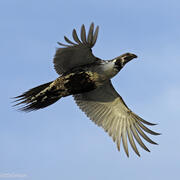Peter Coates, PhD
Dr. Peter Coates is a Wildlife Biologist with the U.S. Geological Survey's Western Ecological Research Center.
He is interested in sound science and management practices aimed at restoring wildlife communities and their habitats. He is committed to progressive, scientifically defensible conservation actions in the face of increasing human population size and individual consumption. Abundance and distribution of wild populations often can be linked to changes in their environments caused by human land use practices, but identifying the ecological mechanisms of declining populations are often challenging. Specifically, Dr. Coates is interested in investigating the links between nesting habitat, predator composition, and incubation behavior and success of birds. Additionally, he is interested in the effects of anthropogenic-resource subsidies on the survival and reproduction of predators and how these changes influence demographics and distribution of prey populations. Dr. Coates seeks to develop a broader understanding of how human-caused landscape changes affect communities and aim to identify restoration practices that preserve natural ecological processes. He is also interested in behavioral traits of grouse that affect population establishment and persistence in the face of environmental challenges.
Professional Experience
Wildlife Biologist, U. S. Geological Survey, 2008–present
Postdoctoral Appointment, Idaho State University, 2008
Seasonal Wildlife Biologist, Wildlife Conservation Society, 2007
Graduate Research Assistantship, Idaho State University, 2002–2007
Teaching Assistantship, Idaho State University, 2004–2007
National Science Foundation GK–12 Teaching F, Idaho State University, 2005–2006
Seasonal Biological Specialist, U. S. Department of Agriculture, 2003–2005
Field Research Technician, University of Nevada Reno, 1999
Conservation Biological Technician I, II, and III, Nevada Department of Wildlife, 1996–1998
Education and Certifications
Ph. D., Biology, Idaho State University 2007
M. S., Biology, University of Nevada Reno 2001
B. S., Conservation Biology, University of Nevada Reno 1998
Affiliations and Memberships*
American Ornithologists Union
Cooper Ornithological Society
Jack H. Berryman Institute
Society for Conservation Biology
The Wildlife Society
Science and Products
Greater Sage-Grouse Population Monitoring Framework
Greater Sage-Grouse Population Monitoring Framework: Trends Analysis Information Sheet
Data Harmonization for Greater Sage-Grouse Populations
Linking post-fire sagebrush restoration and sage-grouse habitat recovery
Can ruderal components of biocrust (mosses and cyanobacteria) be maintained under increasing threats of drought, grazing and feral horses?
Estimating spatial variation in greater sage-grouse lek buffers using seasonal space use models
Fuel Break Treatments in the Sagebrush Biome of the Western United States, 1953 - 2018
Sagebrush recovery projections across the biome, 30 years after two seeding treatment applications, and associated model data (1986-2021)
Communication Towers across the Greater Sage-Grouse Range
Greater sage-grouse habitat suitability 15-years post simulated fire event and sagebrush transplanting (2015-2030)
Greater Sage-Grouse Abundance in Sagebrush Focal Areas near Critical Mineral Resources (ver. 2.0, September 2024)
Rasters and Tables for Selection and Survival of Greater Sage-grouse Nests and Broods in the Bi-State Distinct Population Segment of California and Nevada
Free-roaming horses exceeding appropriate management levels affect multiple vital rates in greater sage-grouse
Hookworm prevalence in ocelots in Costa Rica is inconsistent with spillover from domestic dogs despite high overlap
Modeling the potential habitat gained by planting sagebrush in burned landscapes
Geographic principles applied to population dynamics: A spatially interpolated integrated population model
Status of greater sage-grouse in the Bi-State Distinct Population Segment—An evaluation of population trends, habitat selection, and efficacy of conservation actions
Season of grazing interacts with soil texture, selecting for associations of biocrust morphogroups
Code for a hierarchical model of raven densities linked with sage-grouse nest survival to help guide management of subsidized avian predators, version 1.0
Conservation Planning Tool for the Bi-State Distinct Population Segment of Greater Sage-grouse
Code to Examine How the Influence of Fine-Scale Habitat Characteristics on Greater Sage-Grouse (Centrocercus urophasianus) Nest Site Selection and Nest Survival Varies by Mesic and Xeric Site Conditions version 1.0
rsgis v1.0
raventools v1.0
popcluster: hierarchical population monitoring frameworks, Version 2.0.0
Science and Products
Greater Sage-Grouse Population Monitoring Framework
Greater Sage-Grouse Population Monitoring Framework: Trends Analysis Information Sheet
Data Harmonization for Greater Sage-Grouse Populations
Linking post-fire sagebrush restoration and sage-grouse habitat recovery
Can ruderal components of biocrust (mosses and cyanobacteria) be maintained under increasing threats of drought, grazing and feral horses?
Estimating spatial variation in greater sage-grouse lek buffers using seasonal space use models
Fuel Break Treatments in the Sagebrush Biome of the Western United States, 1953 - 2018
Sagebrush recovery projections across the biome, 30 years after two seeding treatment applications, and associated model data (1986-2021)
Communication Towers across the Greater Sage-Grouse Range
Greater sage-grouse habitat suitability 15-years post simulated fire event and sagebrush transplanting (2015-2030)
Greater Sage-Grouse Abundance in Sagebrush Focal Areas near Critical Mineral Resources (ver. 2.0, September 2024)
Rasters and Tables for Selection and Survival of Greater Sage-grouse Nests and Broods in the Bi-State Distinct Population Segment of California and Nevada
Free-roaming horses exceeding appropriate management levels affect multiple vital rates in greater sage-grouse
Hookworm prevalence in ocelots in Costa Rica is inconsistent with spillover from domestic dogs despite high overlap
Modeling the potential habitat gained by planting sagebrush in burned landscapes
Geographic principles applied to population dynamics: A spatially interpolated integrated population model
Status of greater sage-grouse in the Bi-State Distinct Population Segment—An evaluation of population trends, habitat selection, and efficacy of conservation actions
Season of grazing interacts with soil texture, selecting for associations of biocrust morphogroups
Code for a hierarchical model of raven densities linked with sage-grouse nest survival to help guide management of subsidized avian predators, version 1.0
Conservation Planning Tool for the Bi-State Distinct Population Segment of Greater Sage-grouse
Code to Examine How the Influence of Fine-Scale Habitat Characteristics on Greater Sage-Grouse (Centrocercus urophasianus) Nest Site Selection and Nest Survival Varies by Mesic and Xeric Site Conditions version 1.0
rsgis v1.0
raventools v1.0
popcluster: hierarchical population monitoring frameworks, Version 2.0.0
*Disclaimer: Listing outside positions with professional scientific organizations on this Staff Profile are for informational purposes only and do not constitute an endorsement of those professional scientific organizations or their activities by the USGS, Department of the Interior, or U.S. Government







